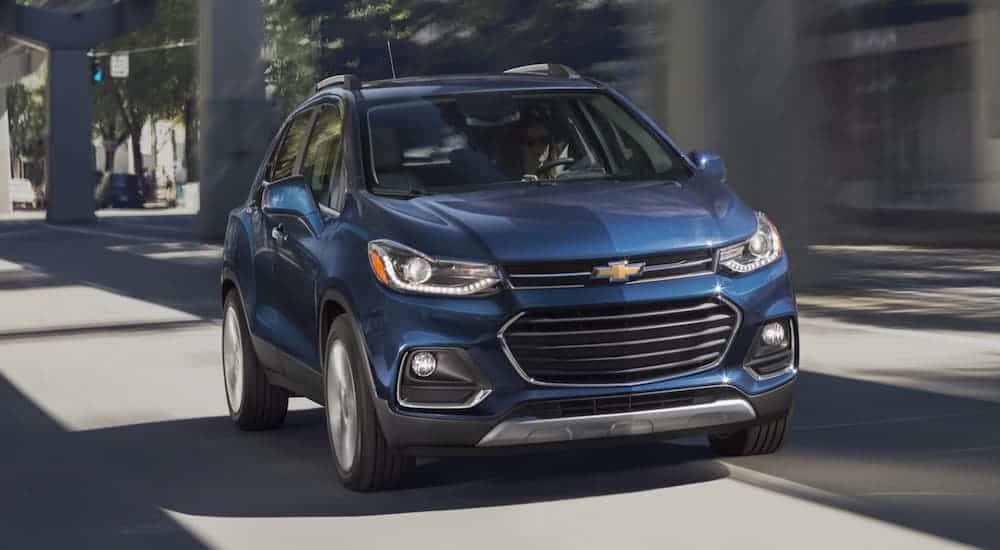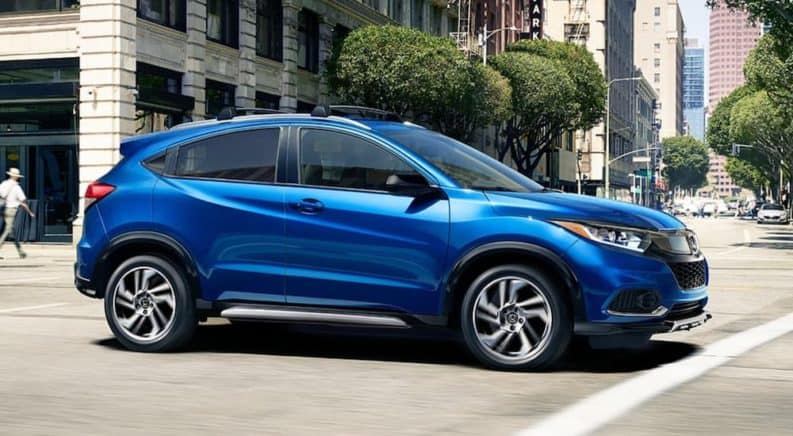The subcompact SUV is a relatively new category of vehicle, but it is becoming increasingly popular. These small SUVs seek to offer the maneuverability, fuel economy, and affordability of a car with the ride height, bad weather performance, and versatility of an SUV. However, this is a tricky balance to strike, and not all subcompact SUVs do so successfully. Let’s look at two popular models and see how the 2020 Honda HR-V vs 2020 Chevy Trax compares.
Both of these vehicles have a strong presence in their segment, although they are also both on the older side and still in their first generations. The Chevy Trax hit the market in 2015, while the Honda HR-V is a year younger with a launch in 2016. This also applies to how recently they have been refreshed, with the Chevy Trax getting its makeover for the 2017 model year, while the Honda HR-V received its major update for the 2019 model year. Together, this means that the Honda HR-V does enjoy a bit of an edge over the Chevy Trax when it comes to features and style.
Powertrain and Reliability
Like most subcompact SUVs, neither the 2020 Honda HR-V nor the 2020 Chevy Trax is going to be winning any drag races. However, that does not mean that they are underpowered for use as a daily driver. The Honda HR-V boasts a 1.8L naturally-aspirated engine with 141 hp and 127 lb-ft of torque, while the Chevy Trax has a 1.4L turbocharged engine with 138 hp and 148 lb-ft of torque. These two engines are fairly comparable on the surface, with the Honda offering a bit more horsepower and the Chevy a bit more torque.
Digging into the details, though, the Honda will offer a smoother ride, better fuel economy, and greater reliability. To begin with, the naturally-aspirated Honda engine will provide better responsiveness than the turbocharged Chevy engine. Further, the Honda HR-V pairs its engine with an efficient continuously-variable transmission while the Chevy Trax continues to use an older six-speed automatic.
This transmission difference means that despite using a theoretically more efficient small turbocharged engine, the Chevy Trax actually has a significantly worse fuel economy than the Honda HR-V. While the Honda makes 28 MPG in the city and 34 MPG on the highway, the Chevy makes only 26 MPG in the city and 31 MPG on the highway. For a class of vehicle that has fuel economy as one of its primary selling points, this is a remarkably poor showing from Chevy.
Finally, the 1.8L naturally-aspirated engine in the Honda HR-V is simply less complex than the 1.4L turbocharged engine in the Chevy Trax. Combine this with Honda’s much better reputation for building bullet-proof engines and low-maintenance vehicles, and the odds are that we will be passing Honda HR-V’s on our daily commutes for years after most Chevy Trax have been consigned to the scrapyard. All in all, Chevy really didn’t bring its A-game to the engineering of its subcompact SUV.

Interior
On the insides of these two vehicles, it is a similar story. Lately, Honda has really stepped up its game when it comes to providing incredible amounts of usable interior space, and the Honda HR-V is no exception. Despite only measuring 3 inches longer than the Chevy Trax, the Honda HR-V provides significantly more passenger and cargo space, making it a much more versatile vehicle.
While the headroom measurements in these two subcompact SUVs are about the same, the Honda is far in the lead when it comes to legroom. Inside the Honda HR-V, second-row passengers will enjoy an impressive 39.3 inches of legroom – more than in many larger SUVs and enough to keep even full-size adults happy on long road trips. Meanwhile, the Chevy Trax is pretty standard for its class, with only 35.7 inches of rear legroom.
The Chevy Trax does score a small victory when it comes to cargo space, offering 29.3 cu.ft. behind the back seats against 24.3 cu.ft. for the Honda HR-V. However, when it comes to maximum cargo space, the Honda is again far in the lead, with 58.8 cu.ft. against just 48.8 cu.ft. for the Chevy. Altogether, the Honda HR-V is simply better at being an SUV than the Chevy Trax. The Honda HR-V can actually handle most of what is needed from a small SUV from hauling purchases from the hardware or furniture store to transporting family, friends, and pets.
Safety
Among the many advantages of the Honda HR-V is its excellent safety. While the Chevy Trax has some marginal crash test scores and restricts its active safety equipment to the top trim, the Honda HR-V is among the safest subcompact SUVs on the streets and was even named a Top Safety Pick by the Insurance Institute for Highway Safety. Although the 2020 Honda HR-V still doesn’t offer the Honda Sensing suite on its lowest trims, these life-saving technologies are standard on over half the trims and are available at a much lower entry cost than on the 2020 Chevy Trax.
The Honda Sensing Suite is also far more capable than the driver-assist technologies available from Chevy and includes some premium features standard. The top trim of the 2020 Chevy Trax comes with forward collision alert, lane departure warning, and blind-spot sensors. However, these systems are alerts only and do not provide automatic braking or automatic steering inputs. This severely reduces their value in actually preventing accidents as the driver will still need to react properly to the warning.
In contrast, the top three trims of the 2020 Honda HR-V come standard with forward collision warning with automatic emergency braking as well as lane departure alert with lane-keeping assist. In addition to these more capable systems, the standard Honda Sensing suite includes adaptive cruise control. This will maintain a set speed on the highway and automatically reduce speed when it encounters slower traffic. Together, these systems make the Honda HR-V significantly safer than the Chevy Trax – and as icing on the cake, they are available for several hundred dollars less.
For a Subcompact SUV, the HR-V is a Remarkable Vehicle
While the subcompact SUV may be increasingly popular, most of the vehicles in this segment fall short of their promise. Instead of offering the best features of a car and an SUV, they often display the worst. The Chevy Trax is among these poor compromises, with the fuel economy of an SUV and the interior space of a compact car. However, the Honda HR-V is a remarkable design that actually lives up to the subcompact SUV ideal.
Although the Honda HR-V will never be the sort of vehicle that will handle true off-roading or comfortably fit a large family, it provides exceptional performance and capability for its segment. With plenty of cargo and passenger space, good fuel economy, and typical rock-solid Honda build quality, it makes for a solid choice for the driver who needs something more than a car without stepping all the way up to a compact or midsize SUV.





